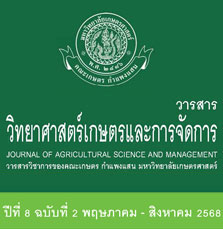Effect of Humic Acid Application on Growth, Yield and Nutrient Uptake of Cherry Tomato (Lycoperisicon esculentum cv. CH 154)
Keywords:
Humic acid, leonardite, cherry tomato, nutrient uptakeAbstract
The humic substances have been used widely for agriculture, which diverse in terms of type and quantity. Our objective was to evaluate the effect of humic acid rates on growth, yield and nutrient uptake of cherry tomato under greenhouse condition. The experiment was operated in a completely randomized design (CRD) with 3 replications and five treatments (0, 25, 50, 75, and 100 kg humic acid/rai). Humic acid used in this study obtained by extraction from leonardite. Tomato plants were grown in the growing media consisted of coconut coir: rice hush ash: sand in the ratio of 2:2:1 by volume (4,200 g/pot) and supplied with Resh tropical dry summer nutrient solution. The results showed that different levels of humic acid application had significant effect on tomato yield, fresh weight, biomass, yield components, lycopene content, and total nutrient uptake (N, P, K, Ca, Mg, Fe, Zn) in different plant parts. Most of the highest values were obtained from 50 kg humic acid/rai addition. Nevertheless, no statistically significant difference was observed among the treatments in terms of total soluble solid. Plant growth, yield and nutrient uptake increased with increasing rates of humic acids; however, there was usually a decrease in the parameters measured at higher rates of humic acid application (75 and 100 kg humic acid/rai). These results indicated that, using 50 kg humic acid/rai would achieve better effects and improve the productivity of tomato
References
กรมวิชาการเกษตร. 2551. คู่มือวิธีวิเคราะห์ปุ๋ยอินทรีย์. กระทรวงเกษตรและสหกรณ์. กรุงเทพฯ. 49 หน้า.
ทัศนีย์ อัตตะนันทน์ และจงรักษ์ จันทร์เจริญสุข. 2542. แบบฝึกหัดและคู่มือปฏิบัติการการวิเคราะห์ดินและพืช. ภาควิชาปฐพีวิทยา คณะเกษตร มหาวิทยาลัยเกษตรศาสตร์. 108 หน้า.
ปิยะ ดวงพัตรา. 2553. สารปรับปรุงดิน. สำนักพิมพ์มหาวิทยาลัยเกษตรศาสตร์, กรุงเทพฯ. 256 หน้า.
ยงยุทธ โอสถสภา. 2557. การใช้สารเร่งชีวภาพเพื่อส่งเสริมการเจริญเติบโตของพืช. วารสารดินและปุ๋ย 36 (1-4):27-54.
สุภานันท์ เงินน้อย. 2557. ผลของกรดฮิวมิกที่สกัดจากลีโอนาร์ไดต์ต่อการเจริญเติบโต ผลผลิต และปริมาณธาตุอาหารของข้าวโพดเลี้ยงสัตว์. วิทยานิพนธ์วิทยาศาสตรมหาบัณฑิต. มหาวิทยาลัยเกษตรศาสตร์, กรุงเทพฯ. 116 หน้า.
Akladious, S.A. and H.I. Mohamed. 2018. Ameliorative effects of calcium nitrate and humic acid on the growth, yield component and biochemical attribute of pepper (Capsicum annuum) plants grown under salt stress. Scientia Horticulturae 236: 244–250.
Beckles, D.M. 2012. Factors affecting the postharvest soluble solids and sugar content of tomato (Solanum lycopersicum L.) fruit. Postharvest Biology and Technology 63(1): 129-140.
Ekinci, M., A. Esringu, A. Dursun, E. Yildirim, M. Turan, M. Rusu Karaman and T. Arjumend. 2015. Growth, yield, and calcium and boron uptake of tomato (Lycopersicon esculentum L.) and cucumber (Cucumis sativus L.) as affected by calcium and boron humate application in greenhouse conditions. Turkish Journal of Agriculture and Forestry 39: 613-623.
Fageria, N.K. 2001. Nutrient interaction in crop plants. Journal of Plant Nutrition 24: 1269-1290.
Labrada, F.P., A.B. Mendoza, A.J. Maldonado, S.S. Gaona and S.G. Morales. 2023. Effects of citric acid and humic-like substances on yield, enzyme activities, and expression of genes involved in iron uptake in tomato plants. Horticulturae 9 (6): 630, https://doi.org/10.3390/horticulturae9060630.
Mora, V., E. Bacaicoa, A.M. Zamarreño, E. Aguirre, M. Garnica and M. Fuentes. 2010. Action of humic acid on promotion of cucumber shoot growth involves nitrate-related changes associated with the root-to-shoot distribution of cytokinins, polyamines and mineral nutrients. Journal of Plant Physiology 167: 633–642.
Moura, O.V.T., R. L.L. Berbara, D.F. de O. Torchia, H.F.O. Da Silva, T.A. van Tol de Castro, O.C.H. Tavares, N.F. Rodrigues, E. Zonta, L.A. Santos and A.C. García. 2023. Humic foliar application as sustainable technology for improving the growth, yield, and abiotic stress protection of agricultural crops. A review. Journal of the Saudi Society of Agricultural Sciences 22: 493-513.
Nagata, M. and I. Yamashita. 1992. Simple method for simultaneous determination of chlorophyll and carotenoids in tomato fruit. Journal of The Japanese Society for Food Science and Technology 39(10): 925-928.
Nardi, S., M.R. Panucci, M.R. Abenavoli and A. Muscolo. 1994. Auxin-like effect of humic substances extracted from faeces of Allolobophora Caliginosa and Allolobophora Rosea. Soil Biology and Biochemistry 23: 833–836.
Nardi, S., M. Schiavon and O. Francioso. 2021. Chemical structure and biological activity of humic substances define their role as plant growth promoters. Molecules 26(8), 2256, https://doi.org/10.3390/molecules26082256
Patti, A. F., W.R. Jackson, S. Norng, M.T. Rose and T.R. Cavagnaro. 2012. Commercial humic substances stimulate tomato growth. pp. 1079-1084. In: International Conference of International Humic Substances Society. Zhejiang University, Hangzhou, China.
Piccolo, A., G. Pietramellara and J.S.C. Mbagwu. 1996. Effects of coal derived humic substances on water retention and structural stability of Mediterranean soils. Soil Use and Management. 12: 209–213.
Piccolo, A. 2002. The supra molecule structure of humic substances: a novel understanding of humus chemistry and implications in soil science. Advances in Agronomy 75: 57-134.
Resh, H.M., 2012, Hydroponic Food Production: a Definitive Guidebook for the Advanced Home Gardener and the Commercial Hydroponic Grower. CRC Press, Boca Raton, Florida. 511 p.
Sutton, R. and G. Sposito. 2005. Molecular structure in soil humic substances: the new view. Environmental Science & Technology 39: 9009-9015.
Sani, B. 2014. Foliar application of humic acid on plant height in canola. pp. 82-86. In: 2013 4th International Conference on Agriculture and Animal Science (CAAS 2013) and 2013 3rd International Conference on Asia Agriculture and Animal (ICAAA 2013). Phuket, Thailand.
Tan, K.H. 2003. Humic Matter in Soil and the Environment: Principles and Controversies. Marcel Dekker Inc., New York. 459 p.
Valdrighi, l. M., A. Pera, M. Agnolucci, S. Frassinetti, D. Lunardi and G. Vallini. 1996. Effects of compost-derived humic acids on vegetable biomass production and microbial growth within a plant (Cichorium intybus)-soil system: a comparative study. Agriculture, Ecosystems & Environment 58 (2-3): 133-144.
Yildrim, E. 2007. Foliar and soil fertilization of humic acid affect productivity and quality of tomato. Acta Agriculturae Scandinavica (57): 182–186, Section B.
Zandonadi, D.B., M.P., Santos, L.B., Dobbss, F.L., Olivares, L.P., Canellas, M.L. Binzel, ,A.L. Okorokova-Façanha and A.R. Façanha. 2010. Nitric oxide mediates humic acids-induced root development and plasma membrane H+-ATPase activation. Planta 231 (5): 1025–1036
Zhang, J. H. Yin, H. Wang, L. Xu, B. Samuel, J. Chang, F. Liu and H. Chen. 2019. Molecular structure-reactivity correlations of humic acid and humin fractions from a typical black soil for hexavalent chromium reduction. Science of The Total Environment 651 (2): 2975-2984.






